Page 356 of 429
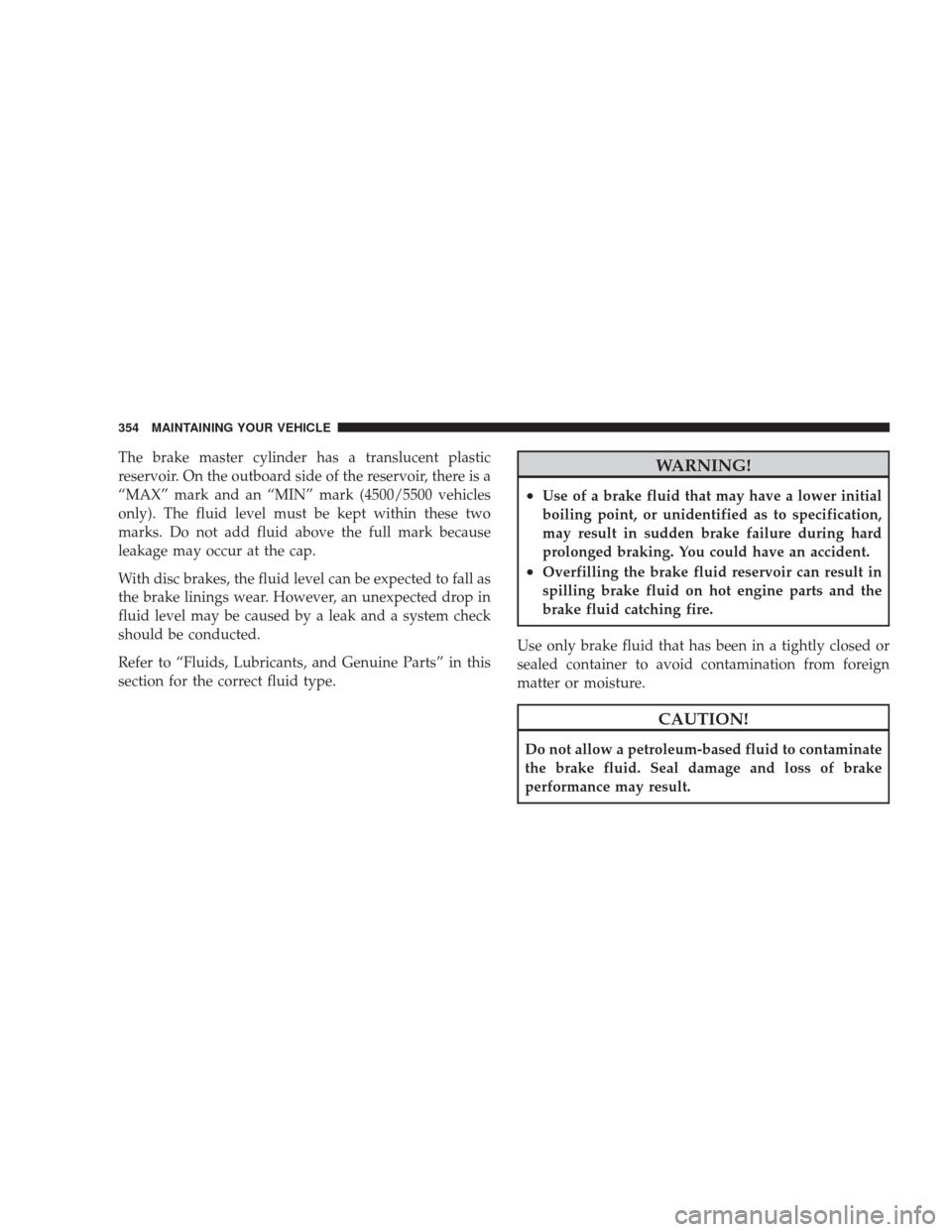
The brake master cylinder has a translucent plastic
reservoir. On the outboard side of the reservoir, there is a
“MAX” mark and an “MIN” mark (4500/5500 vehicles
only). The fluid level must be kept within these two
marks. Do not add fluid above the full mark because
leakage may occur at the cap.
With disc brakes, the fluid level can be expected to fall as
the brake linings wear. However, an unexpected drop in
fluid level may be caused by a leak and a system check
should be conducted.
Refer to “Fluids, Lubricants, and Genuine Parts” in this
section for the correct fluid type.WARNING!
•Use of a brake fluid that may have a lower initial
boiling point, or unidentified as to specification,
may result in sudden brake failure during hard
prolonged braking. You could have an accident.
•Overfilling the brake fluid reservoir can result in
spilling brake fluid on hot engine parts and the
brake fluid catching fire.
Use only brake fluid that has been in a tightly closed or
sealed container to avoid contamination from foreign
matter or moisture.
CAUTION!
Do not allow a petroleum-based fluid to contaminate
the brake fluid. Seal damage and loss of brake
performance may result.
354 MAINTAINING YOUR VEHICLE
Page 358 of 429
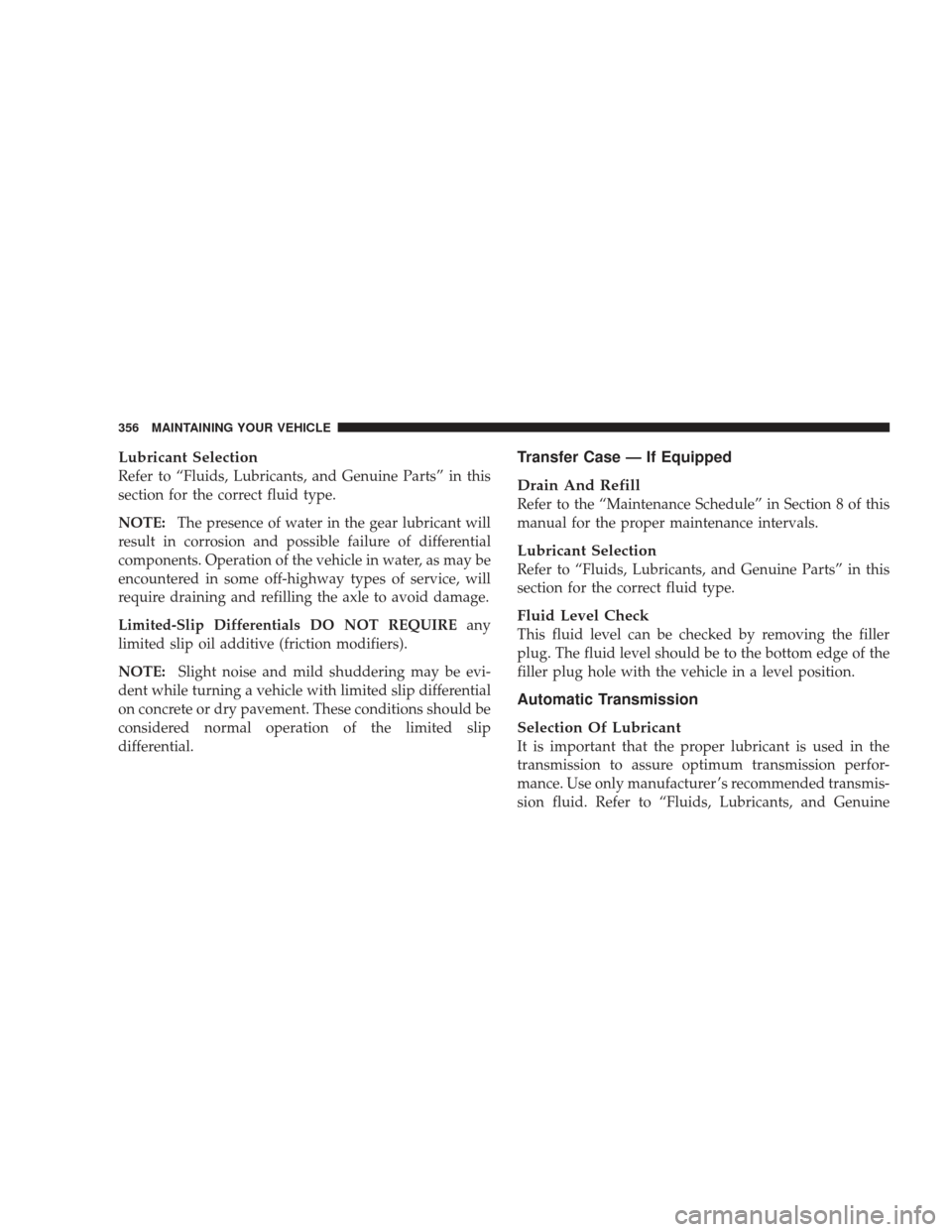
Lubricant Selection
Refer to “Fluids, Lubricants, and Genuine Parts” in this
section for the correct fluid type.
NOTE:The presence of water in the gear lubricant will
result in corrosion and possible failure of differential
components. Operation of the vehicle in water, as may be
encountered in some off-highway types of service, will
require draining and refilling the axle to avoid damage.
Limited-Slip Differentials DO NOT REQUIRE any
limited slip oil additive (friction modifiers).
NOTE: Slight noise and mild shuddering may be evi-
dent while turning a vehicle with limited slip differential
on concrete or dry pavement. These conditions should be
considered normal operation of the limited slip
differential.
Transfer Case — If Equipped
Drain And Refill
Refer to the “Maintenance Schedule” in Section 8 of this
manual for the proper maintenance intervals.
Lubricant Selection
Refer to “Fluids, Lubricants, and Genuine Parts” in this
section for the correct fluid type.
Fluid Level Check
This fluid level can be checked by removing the filler
plug. The fluid level should be to the bottom edge of the
filler plug hole with the vehicle in a level position.
Automatic Transmission
Selection Of Lubricant
It is important that the proper lubricant is used in the
transmission to assure optimum transmission perfor-
mance. Use only manufacturer ’s recommended transmis-
sion fluid. Refer to “Fluids, Lubricants, and Genuine
356 MAINTAINING YOUR VEHICLE
Page 360 of 429
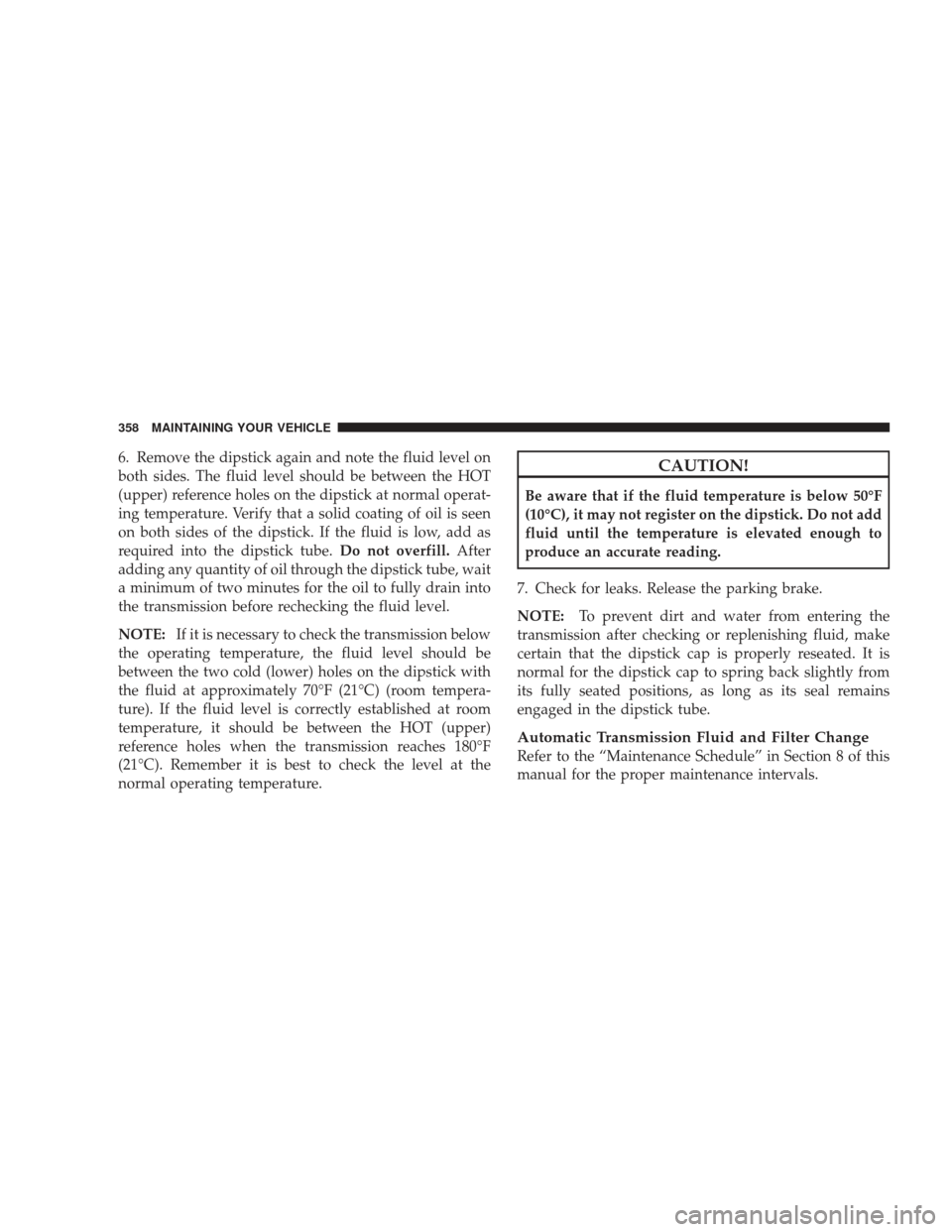
6. Remove the dipstick again and note the fluid level on
both sides. The fluid level should be between the HOT
(upper) reference holes on the dipstick at normal operat-
ing temperature. Verify that a solid coating of oil is seen
on both sides of the dipstick. If the fluid is low, add as
required into the dipstick tube.Do not overfill.After
adding any quantity of oil through the dipstick tube, wait
a minimum of two minutes for the oil to fully drain into
the transmission before rechecking the fluid level.
NOTE: If it is necessary to check the transmission below
the operating temperature, the fluid level should be
between the two cold (lower) holes on the dipstick with
the fluid at approximately 70°F (21°C) (room tempera-
ture). If the fluid level is correctly established at room
temperature, it should be between the HOT (upper)
reference holes when the transmission reaches 180°F
(21°C). Remember it is best to check the level at the
normal operating temperature.CAUTION!
Be aware that if the fluid temperature is below 50°F
(10°C), it may not register on the dipstick. Do not add
fluid until the temperature is elevated enough to
produce an accurate reading.
7. Check for leaks. Release the parking brake.
NOTE: To prevent dirt and water from entering the
transmission after checking or replenishing fluid, make
certain that the dipstick cap is properly reseated. It is
normal for the dipstick cap to spring back slightly from
its fully seated positions, as long as its seal remains
engaged in the dipstick tube.
Automatic Transmission Fluid and Filter Change
Refer to the “Maintenance Schedule” in Section 8 of this
manual for the proper maintenance intervals.
358 MAINTAINING YOUR VEHICLE
Page 363 of 429
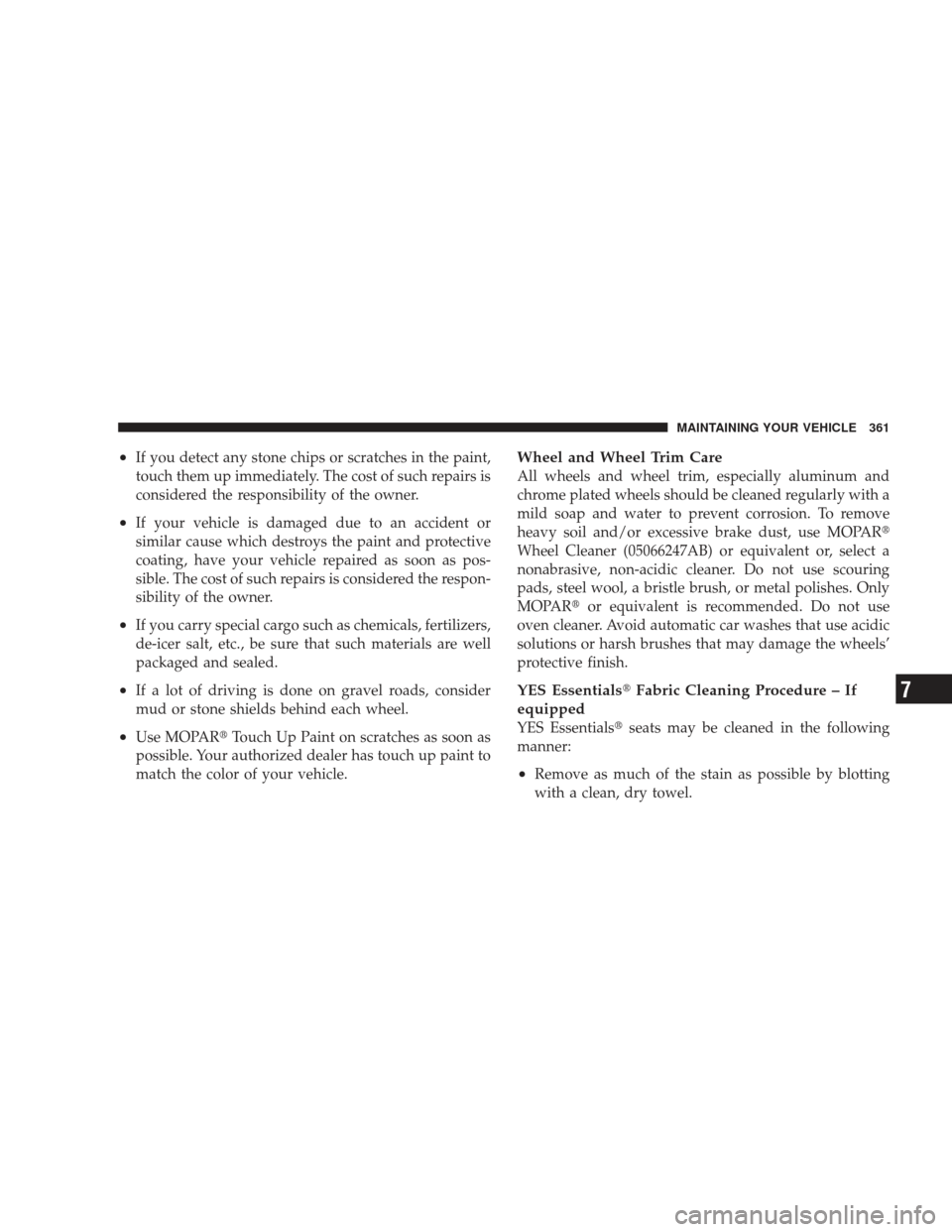
•If you detect any stone chips or scratches in the paint,
touch them up immediately. The cost of such repairs is
considered the responsibility of the owner.
•If your vehicle is damaged due to an accident or
similar cause which destroys the paint and protective
coating, have your vehicle repaired as soon as pos-
sible. The cost of such repairs is considered the respon-
sibility of the owner.
•If you carry special cargo such as chemicals, fertilizers,
de-icer salt, etc., be sure that such materials are well
packaged and sealed.
•If a lot of driving is done on gravel roads, consider
mud or stone shields behind each wheel.
•Use MOPAR�Touch Up Paint on scratches as soon as
possible. Your authorized dealer has touch up paint to
match the color of your vehicle.
Wheel and Wheel Trim Care
All wheels and wheel trim, especially aluminum and
chrome plated wheels should be cleaned regularly with a
mild soap and water to prevent corrosion. To remove
heavy soil and/or excessive brake dust, use MOPAR �
Wheel Cleaner (05066247AB) or equivalent or, select a
nonabrasive, non-acidic cleaner. Do not use scouring
pads, steel wool, a bristle brush, or metal polishes. Only
MOPAR� or equivalent is recommended. Do not use
oven cleaner. Avoid automatic car washes that use acidic
solutions or harsh brushes that may damage the wheels’
protective finish.
YES Essentials� Fabric Cleaning Procedure – If
equipped
YES Essentials� seats may be cleaned in the following
manner:
•Remove as much of the stain as possible by blotting
with a clean, dry towel.
MAINTAINING YOUR VEHICLE 361
7
Page 364 of 429
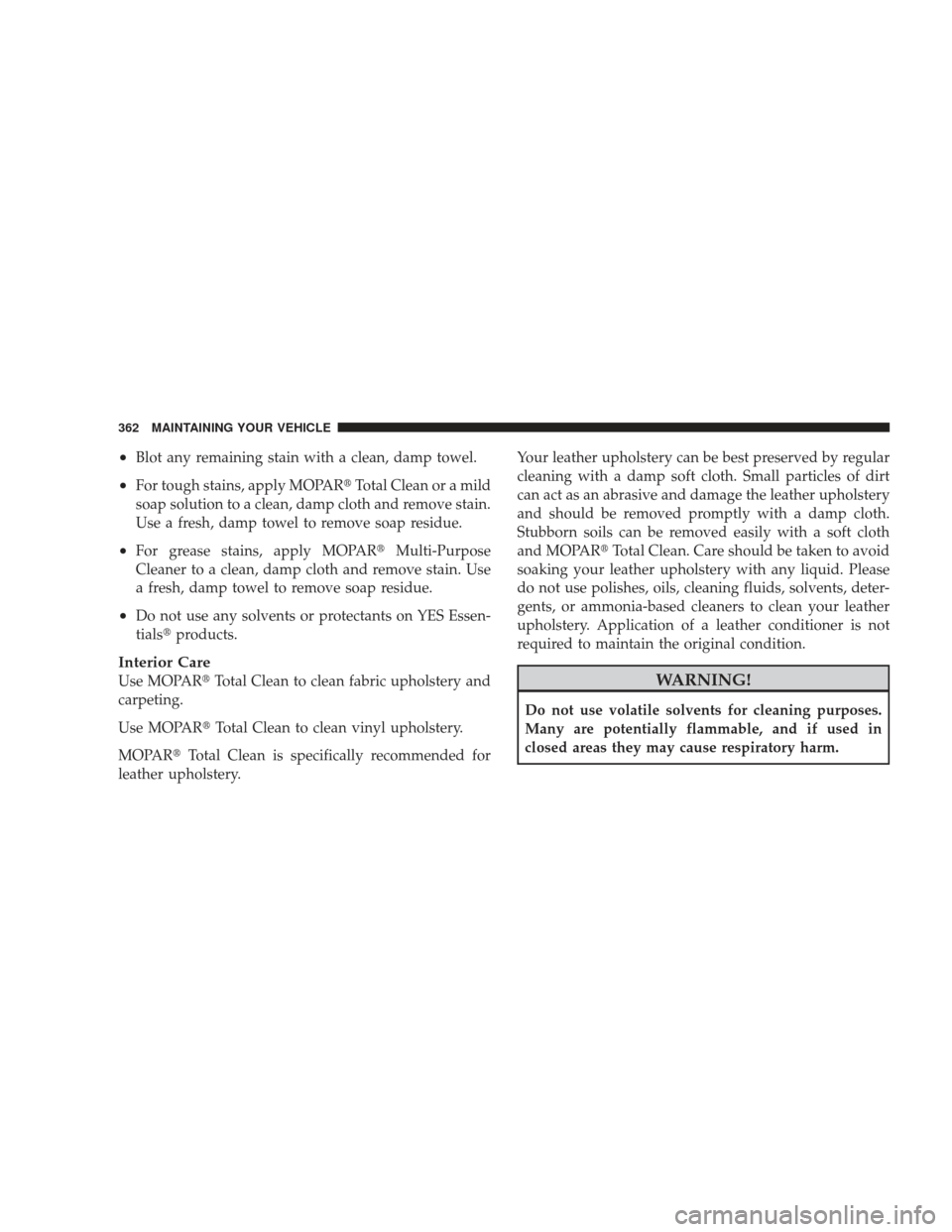
•Blot any remaining stain with a clean, damp towel.
•For tough stains, apply MOPAR�Total Clean or a mild
soap solution to a clean, damp cloth and remove stain.
Use a fresh, damp towel to remove soap residue.
•For grease stains, apply MOPAR� Multi-Purpose
Cleaner to a clean, damp cloth and remove stain. Use
a fresh, damp towel to remove soap residue.
•Do not use any solvents or protectants on YES Essen-
tials� products.
Interior Care
Use MOPAR� Total Clean to clean fabric upholstery and
carpeting.
Use MOPAR� Total Clean to clean vinyl upholstery.
MOPAR� Total Clean is specifically recommended for
leather upholstery. Your leather upholstery can be best preserved by regular
cleaning with a damp soft cloth. Small particles of dirt
can act as an abrasive and damage the leather upholstery
and should be removed promptly with a damp cloth.
Stubborn soils can be removed easily with a soft cloth
and MOPAR�
Total Clean. Care should be taken to avoid
soaking your leather upholstery with any liquid. Please
do not use polishes, oils, cleaning fluids, solvents, deter-
gents, or ammonia-based cleaners to clean your leather
upholstery. Application of a leather conditioner is not
required to maintain the original condition.WARNING!
Do not use volatile solvents for cleaning purposes.
Many are potentially flammable, and if used in
closed areas they may cause respiratory harm.
362 MAINTAINING YOUR VEHICLE
Page 379 of 429
FLUID AND CAPACITIES
U.S.Metric
Fuel (Approximate)
Standard Rear Tank 52 Gallons197 Liters
Optional Midship Tank 22 Gallons83 Liters
Engine Oil with Filter
5.7L Engine (SAE 5W-20, API Certified) (For vehicles
operating under a gross combined weight rating less
than 14,000 lbs.) 7 Quarts
6.6 Liters
5.7L Engine (SAE 5W-30, API Certified) (For vehicles
operating under a gross combined weight rating
greater than 14,000 lbs.) 7 Quarts
6.6 Liters
Cooling System
5.7L Engine (MOPAR� Antifreeze/Coolant 5
Year/100,000 Mile Formula) or equivalent. 18.7 Quarts
17.7 Liters
MAINTAINING YOUR VEHICLE 377
7
Page 380 of 429
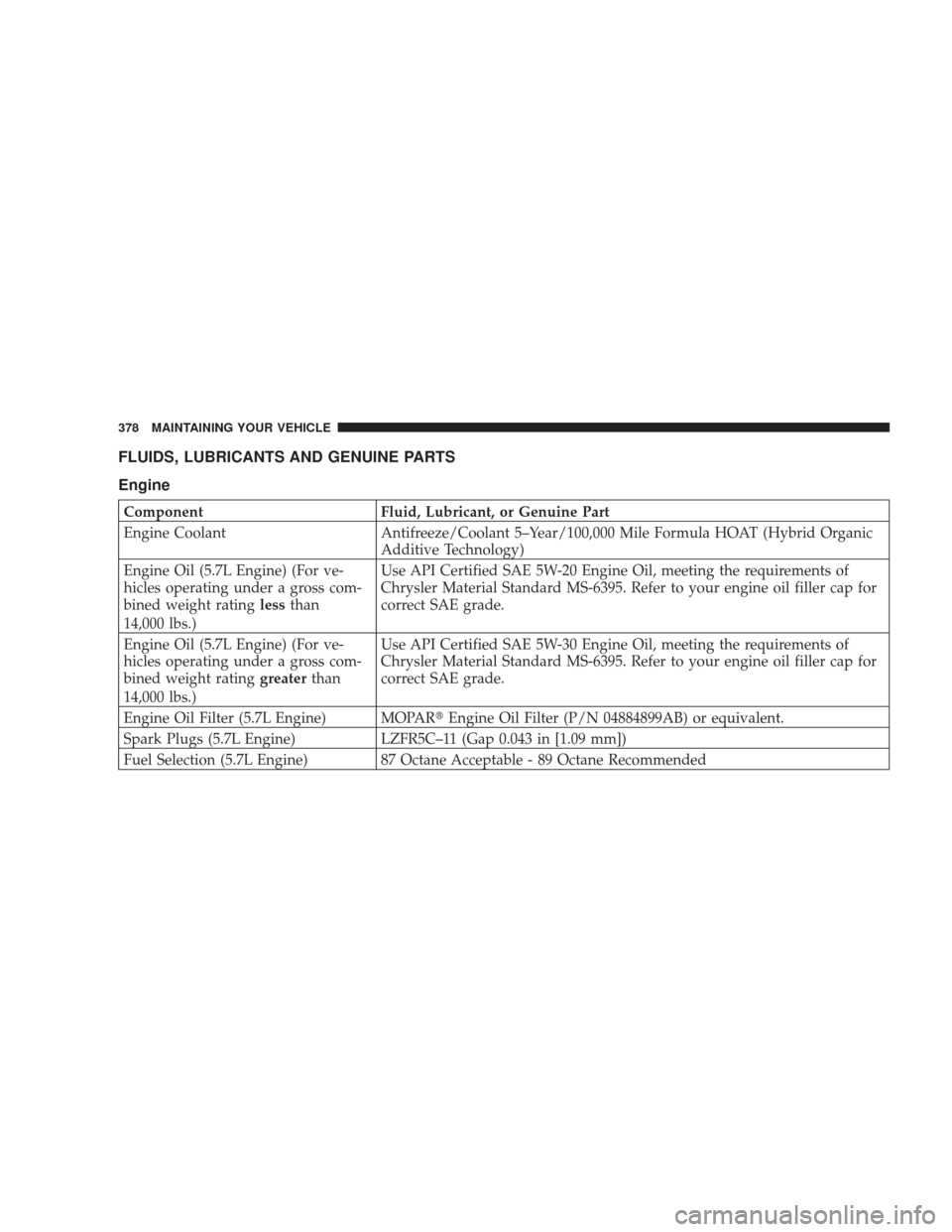
FLUIDS, LUBRICANTS AND GENUINE PARTS
Engine
ComponentFluid, Lubricant, or Genuine Part
Engine Coolant Antifreeze/Coolant 5–Year/100,000 Mile Formula HOAT (Hybrid Organic
Additive Technology)
Engine Oil (5.7L Engine) (For ve-
hicles operating under a gross com-
bined weight rating lessthan
14,000 lbs.) Use API Certified SAE 5W-20 Engine Oil, meeting the requirements of
Chrysler Material Standard MS-6395. Refer to your engine oil filler cap for
correct SAE grade.
Engine Oil (5.7L Engine) (For ve-
hicles operating under a gross com-
bined weight rating greaterthan
14,000 lbs.) Use API Certified SAE 5W-30 Engine Oil, meeting the requirements of
Chrysler Material Standard MS-6395. Refer to your engine oil filler cap for
correct SAE grade.
Engine Oil Filter (5.7L Engine) MOPAR� Engine Oil Filter (P/N 04884899AB) or equivalent.
Spark Plugs (5.7L Engine) LZFR5C–11 (Gap 0.043 in [1.09 mm])
Fuel Selection (5.7L Engine) 87 Octane Acceptable - 89 Octane Recommended
378 MAINTAINING YOUR VEHICLE
Page 384 of 429
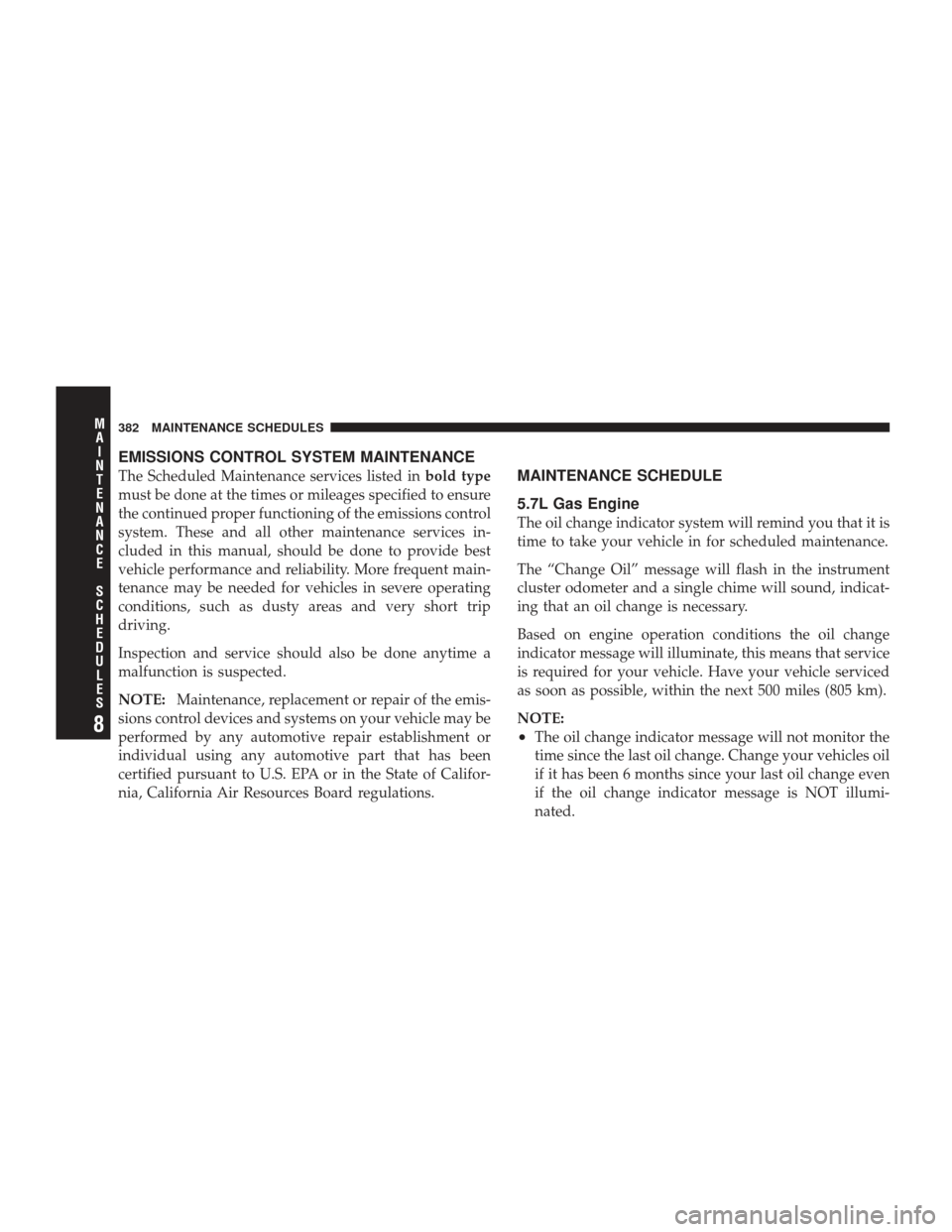
EMISSIONS CONTROL SYSTEM MAINTENANCE
The Scheduled Maintenance services listed inbold type
must be done at the times or mileages specified to ensure
the continued proper functioning of the emissions control
system. These and all other maintenance services in-
cluded in this manual, should be done to provide best
vehicle performance and reliability. More frequent main-
tenance may be needed for vehicles in severe operating
conditions, such as dusty areas and very short trip
driving.
Inspection and service should also be done anytime a
malfunction is suspected.
NOTE: Maintenance, replacement or repair of the emis-
sions control devices and systems on your vehicle may be
performed by any automotive repair establishment or
individual using any automotive part that has been
certified pursuant to U.S. EPA or in the State of Califor-
nia, California Air Resources Board regulations.MAINTENANCE SCHEDULE
5.7L Gas Engine
The oil change indicator system will remind you that it is
time to take your vehicle in for scheduled maintenance.
The “Change Oil” message will flash in the instrument
cluster odometer and a single chime will sound, indicat-
ing that an oil change is necessary.
Based on engine operation conditions the oil change
indicator message will illuminate, this means that service
is required for your vehicle. Have your vehicle serviced
as soon as possible, within the next 500 miles (805 km).
NOTE:
•The oil change indicator message will not monitor the
time since the last oil change. Change your vehicles oil
if it has been 6 months since your last oil change even
if the oil change indicator message is NOT illumi-
nated.
382 MAINTENANCE SCHEDULES
8
M A I
N T
E
N A
N CE
S
C
H E
D
U L
E
S